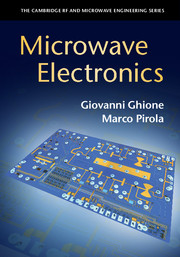Book contents
- Frontmatter
- Dedication
- Contents
- Preface
- Notation and Symbols
- 1 A System Introduction to Microwave Electronics
- 2 Passive Elements and Circuit Layout
- 3 CAD Techniques
- 4 Directional Couplers and Power Dividers
- 5 Active RF and Microwave Semiconductor Devices
- 6 Microwave Linear Amplifiers
- 7 Low-Noise Amplifier Design
- 8 Power Amplifiers
- 9 Microwave Measurements
- 10 CAD Projects
- Index
- References
1 - A System Introduction to Microwave Electronics
Published online by Cambridge University Press: 10 November 2017
- Frontmatter
- Dedication
- Contents
- Preface
- Notation and Symbols
- 1 A System Introduction to Microwave Electronics
- 2 Passive Elements and Circuit Layout
- 3 CAD Techniques
- 4 Directional Couplers and Power Dividers
- 5 Active RF and Microwave Semiconductor Devices
- 6 Microwave Linear Amplifiers
- 7 Low-Noise Amplifier Design
- 8 Power Amplifiers
- 9 Microwave Measurements
- 10 CAD Projects
- Index
- References
Summary
Radio Frequencies, Microwaves, Millimeter Waves
The meaning of high-speed and high-frequency electronics has changed in a century of technological evolution; see [1]. Radio-frequencies (RF) were at first introduced within the framework of radio broadcasting and point-to-point transmission at the beginning of the twentieth century; however, new applications (such as TV broadcasting and above all the radar around 1940), fostered in turn by the availability of RF signal generators at increasing frequency, caused a gradual explosion of new application fields in the RF, microwave and millimeter wave frequency bands. Before 1970, high-frequency systems were based on vacuum tube generators; in the following decades, solid-state semiconductor devices able to operate above 1 GHz, based both on Silicon and on compound semiconductor technologies, were gradually introduced, leading to a new paradigm, the hybrid and then monolithic Microwave Integrated Circuit, (M)MIC, see, e.g., [1, Ch. 16]. Integration and the resulting downsizing of RF and microwave systems ultimately made microwave electronics, at least in high-volume applications, a low-cost commodity well suited to the consumer market.
For the sake of clarity, let us focus on the meaning of the terms RF, microwaves and millimeter waves and on some of the significant applications in each frequency band:
• The RF band includes frequencies between a few MHz and 1 GHz, with free space wavelengths of the order of 1 m (30 cm at 1 GHz); the applications include analog radio broadcasting through frequency modulation (FM), and also many other systems, like TV broadcasting, point-to-point communications (for instance, the lowest band in European GSM systems), long-range radar systems, industrial applications like RF heating and RF drying.
• The microwave frequency band includes frequencies between 1 GHz and 30 GHz, with free space wavelengths between 30 cm and 1 cm. In the microwave range, several applications exist: below 10 GHz we have all mobile phone systems up to the LTE (Long-Term Evolution, commonly known as 4G LTE) standard, many Wireless Local Area Network (WLAN) applications, terrestrial and satellite radio links, radar systems, positioning systems. Also the electronic part of long-haul optical communication systems operates in this band, although in this case many of the exploited circuit architectures are digital rather than analog.
- Type
- Chapter
- Information
- Microwave Electronics , pp. 1 - 27Publisher: Cambridge University PressPrint publication year: 2017



